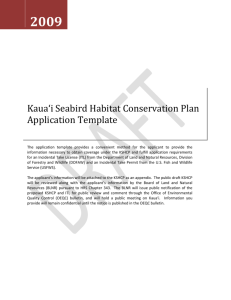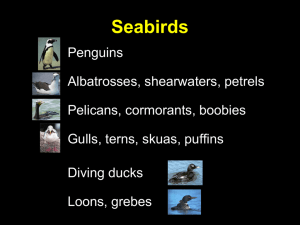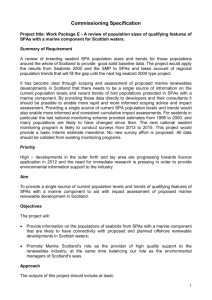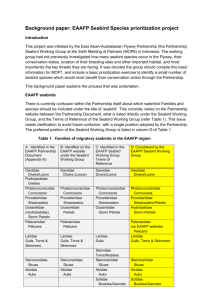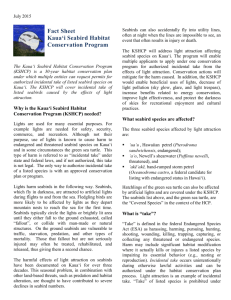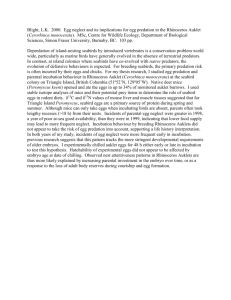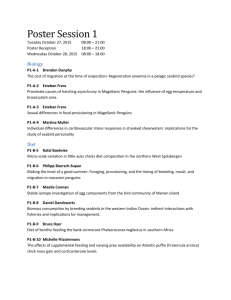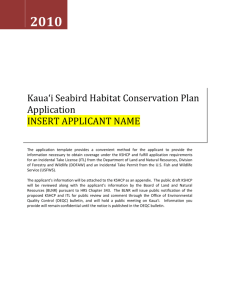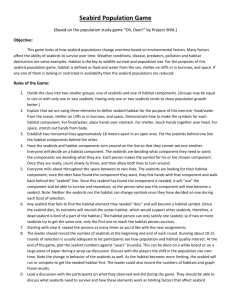Serving the Global Village through ... Paradigm for Seabird Biologists and ...
advertisement
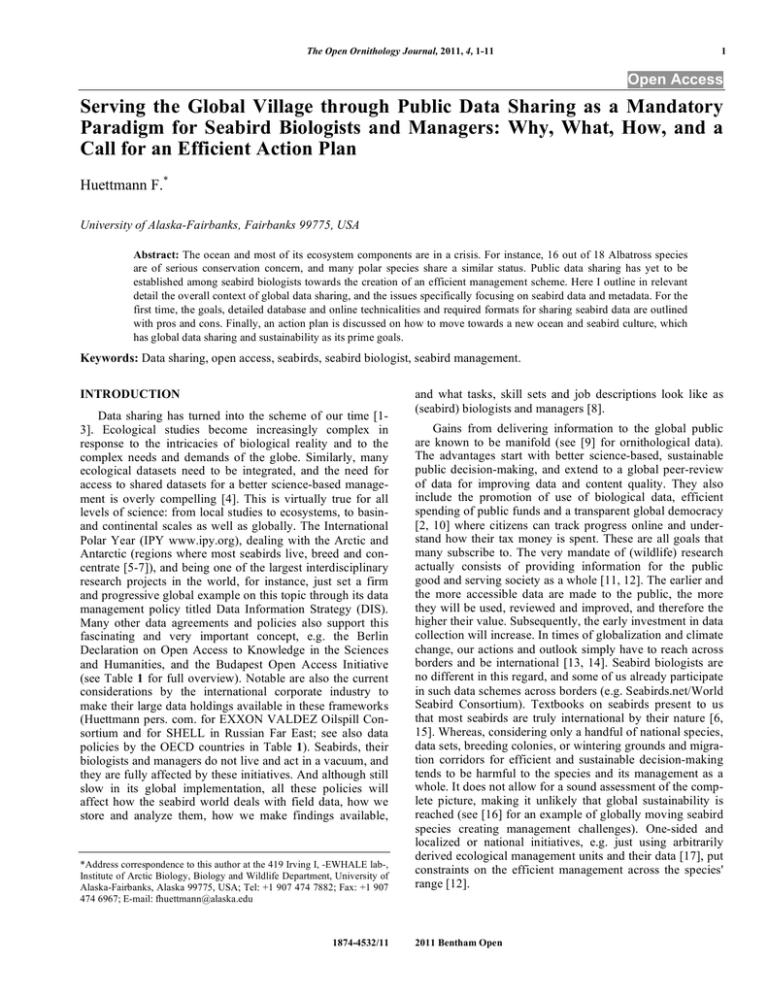
The Open Ornithology Journal, 2011, 4, 1-11 1 Open Access Serving the Global Village through Public Data Sharing as a Mandatory Paradigm for Seabird Biologists and Managers: Why, What, How, and a Call for an Efficient Action Plan Huettmann F.* University of Alaska-Fairbanks, Fairbanks 99775, USA Abstract: The ocean and most of its ecosystem components are in a crisis. For instance, 16 out of 18 Albatross species are of serious conservation concern, and many polar species share a similar status. Public data sharing has yet to be established among seabird biologists towards the creation of an efficient management scheme. Here I outline in relevant detail the overall context of global data sharing, and the issues specifically focusing on seabird data and metadata. For the first time, the goals, detailed database and online technicalities and required formats for sharing seabird data are outlined with pros and cons. Finally, an action plan is discussed on how to move towards a new ocean and seabird culture, which has global data sharing and sustainability as its prime goals. Keywords: Data sharing, open access, seabirds, seabird biologist, seabird management. INTRODUCTION Data sharing has turned into the scheme of our time [13]. Ecological studies become increasingly complex in response to the intricacies of biological reality and to the complex needs and demands of the globe. Similarly, many ecological datasets need to be integrated, and the need for access to shared datasets for a better science-based management is overly compelling [4]. This is virtually true for all levels of science: from local studies to ecosystems, to basinand continental scales as well as globally. The International Polar Year (IPY www.ipy.org), dealing with the Arctic and Antarctic (regions where most seabirds live, breed and concentrate [5-7]), and being one of the largest interdisciplinary research projects in the world, for instance, just set a firm and progressive global example on this topic through its data management policy titled Data Information Strategy (DIS). Many other data agreements and policies also support this fascinating and very important concept, e.g. the Berlin Declaration on Open Access to Knowledge in the Sciences and Humanities, and the Budapest Open Access Initiative (see Table 1 for full overview). Notable are also the current considerations by the international corporate industry to make their large data holdings available in these frameworks (Huettmann pers. com. for EXXON VALDEZ Oilspill Consortium and for SHELL in Russian Far East; see also data policies by the OECD countries in Table 1). Seabirds, their biologists and managers do not live and act in a vacuum, and they are fully affected by these initiatives. And although still slow in its global implementation, all these policies will affect how the seabird world deals with field data, how we store and analyze them, how we make findings available, *Address correspondence to this author at the 419 Irving I, -EWHALE lab-, Institute of Arctic Biology, Biology and Wildlife Department, University of Alaska-Fairbanks, Alaska 99775, USA; Tel: +1 907 474 7882; Fax: +1 907 474 6967; E-mail: fhuettmann@alaska.edu 1874-4532/11 and what tasks, skill sets and job descriptions look like as (seabird) biologists and managers [8]. Gains from delivering information to the global public are known to be manifold (see [9] for ornithological data). The advantages start with better science-based, sustainable public decision-making, and extend to a global peer-review of data for improving data and content quality. They also include the promotion of use of biological data, efficient spending of public funds and a transparent global democracy [2, 10] where citizens can track progress online and understand how their tax money is spent. These are all goals that many subscribe to. The very mandate of (wildlife) research actually consists of providing information for the public good and serving society as a whole [11, 12]. The earlier and the more accessible data are made to the public, the more they will be used, reviewed and improved, and therefore the higher their value. Subsequently, the early investment in data collection will increase. In times of globalization and climate change, our actions and outlook simply have to reach across borders and be international [13, 14]. Seabird biologists are no different in this regard, and some of us already participate in such data schemes across borders (e.g. Seabirds.net/World Seabird Consortium). Textbooks on seabirds present to us that most seabirds are truly international by their nature [6, 15]. Whereas, considering only a handful of national species, data sets, breeding colonies, or wintering grounds and migration corridors for efficient and sustainable decision-making tends to be harmful to the species and its management as a whole. It does not allow for a sound assessment of the complete picture, making it unlikely that global sustainability is reached (see [16] for an example of globally moving seabird species creating management challenges). One-sided and localized or national initiatives, e.g. just using arbitrarily derived ecological management units and their data [17], put constraints on the efficient management across the species' range [12]. 2011 Bentham Open 2 The Open Ornithology Journal, 2011, Volume 4 Huettmann F. TO conducted globally and funded for decades? How high is the percentage of data that has been lost? Same as in many other research disciplines, seabird biologists are funded through various sources (referred to as ‘mixed funding’). Thus, their goals and objectives, and the associated research cultures, can strongly vary. Seabird data can be complex, and often include auxiliary data, e.g. prey species to be identified at various scales, or ocean data. The actual data formats can also differ strongly, and funds are often not available or budgeted for to deal with all relevant data components adequately, e.g. data documentation, maintenance and delivery. This lack of available data is probably because much of the acquisition of pelagic seabird field data is either driven by oil spill questions ([23] for an overview; [24]), commercial fisheries [25] or other industry-related impact studies [26], see [27] for a general example). Huge seabird data schemes were specifically set up or motivated for these reasons ([28, 29]; see North Pacific Research Board http://www.nprb.org/ for a funding body). These funds allowed for the data collections, but their projects were foremost part of legal public procedures and done to satisfy the environmental concern, often for the already decided goahead of projects (see [30] stating that such procedures dominate). In earlier project set-ups, legal clauses stating that raw data must not be shared with the general public were often found. SPECIFIC BACKGROUND SEABIRDS AND DATA IN REGARDS Most seabird research and management is currently driven by five main players: governments, university researchers, private industry (e.g. fishery), contractors (e.g. Impact Assessment Companies) and NGOs (Non-Governmental Organizations). In terms of data policies, the first two should adhere to governmental policy and legislation, namely the Freedom of Information Act (FOIA), National Spatial Data Infrastructure (NSDI), Data Quality Act (DQA), and related policies (this is the case for North America and for many countries with a similar type of democracy; see Table 1). This situation is due to the fact that the involvement of federal funds in projects invokes these legal acts automatically. But in times of drastic economic pressures, where older global copyrights and ownerships still play a large role (see [18] for global copyright laws TRIPS http://en. wikipedia. org/wiki/Agreement_on_Trade-Related_ Aspects _of_Intellectual_Property_Rights and its problems), and where funds controlled by industry and international conglomerates are such big global drivers [14, 19], ‘free and digital data delivery’ is in danger of becoming an empty buzz word. This is even more true when considering boldly announced international data sharing policies, such as between the U.S. and England, or the EU and Japan (Table 1). In reality, they do not automatically result into the public release of all seabird-related fisheries raw data for instance, or for setting up a transparent data culture. Many seabirdrelated fisheries are publicly funded/subsidized and operating on public ground and resource. Therefore, the basic rules of governmental transparency and justification for spending public funds should be followed. Although some strides have been made, e.g. [20-22], the discipline of seabird research is currently not a recognized leader, nor a main player in (digital) data delivery to the global public. The apparent lack of transparency in seabird data may therefore play directly into the hands of lobbies that promote commercializing and even privatizing the oceans (otherwise a public good). THE SEABIRD DATA SITUATION: THREE DIGITAL DIVIDES AT ONCE When it comes to seabirds, we can observe a classic case of the ‘digital divide’ [18], but in a triple form even: between seabird investigators of the 1st world vs. the rest of the world (= over two-thirds of the human population), between the young and old generation, and between the public vs. agencies and industries (often referred to as the ‘Iron Triangle’ [19]). One will easily find this profile for most seabird research and its data situations; how many clean raw data do we really have at hand from all the seabird research Fisheries issues are another major industrial driver and funder for pelagic seabird data-collection [31, 32]. These can be characterized by similar lobby pressures against making their data freely available [33]. The widely cited American Magnuson-Stevens Act (often referred to as a great success story and the legal basis for the “Best Managed Fisheries in the World”) for instance is rather explicit in NOT making data public; it achieves this U.S.-wide through its semiprivate Fisheries Councils (a text book example for an Iron Triangle driving to-be sustainable ocean resource decisions). Thus, many participants in the seabird world are not used to data sharing, yet, and still perceive 'freely shared data' as unheard of, unrealistic or even undesirable. Great synergies that could be achieved through the general use and sharing of data are virtually lost. In these circles, data ownership is often still equated with power; and thus, data are not widely released. Questions on kick-backs, e.g. conditional coauthorship when using these data, are commonly demanded as well. Such attitudes are clearly counterproductive in order to reach the outlined goals of a sustainable and global village (e.g. not losing wilderness and species, maintenance and the general improvement of ecological services, environmental justice, equal rights to all citizens, efficient management of a public good; [11, 18, 34]). They are further in complete disagreement for achieving an efficient wildlife management that is based on transparent and repeatable science [12]. But despite not making their own raw data available globally, many seabird researchers and managers are nevertheless very happy to take publicly available ocean habitat data for granted. Many use free sea surface temperature, bathymetry, ocean current, weather or chlorophyll data provided by other disciplines and scientists for their own projects and gains. The widely used World Ocean Atlas (WOA) is such an example. Many seabird biologists like to receive, but what do they give and how do they serve the community and share? Some seabird biologists may “serve” by soliciting and getting funds to study pressing conservation or management issues, collecting pertinent data, analyzing them (and yes, often in reference to available environmental data), and disseminating results in final reports, proceedings, peerreviewed journals, with PDFs and through public media, where appropriate. Such a body of information is traditionally used by management agencies to manage wildlife and create policy, often with huge biases and delays, and just Serving the Global Village through Public Data Sharing Table 1. The Open Ornithology Journal, 2011, Volume 4 3 Selection of Relevant Data Policies for Seabird Data Access World-Wide Policy Name (Abbreviation), Year URL Effect Spatial Applicability U.S. the Freedom of Information Act (FOIA), 1994 http://www.usdoj.gov/oip/index.html Federal Governmental data paid by tax money need to be made publicly available U.S. National Spatial Data Infrastructure (NSDI), 1994 http://www.fgdc.gov/nsdi/nsdi.html/ Governmental spatial data paid by tax money need to follow outlined standards U.S. Data Quality Act (DQA) 2002 http://thecre.com/quality/index.html http://en.wikipedia.org/wiki/Data_Quality_Act Government needs to strive for highest possible data quality U.S. IPY Data Information Strategy (IPY DIS), 2007 http://nsidc.org/events/ipydis IPY Data need to follow free digital Open Access All countries supporting IPY Participants’ Statement On Free and Open Data Access by ENBI-GBIF's, 2005 Digitisation Workshop in Chania Greece, 2005 http://circa.gbif.net/irc/DownLoad/kweFA8Jem 3GRH4gp8XPskTqrV GhuJSt0/dYJuMj6/ Data%20Access%20 Statement.pdf Free, Digital and Open Access of Data All GBIF and Rio Convention signature countries Budapest Open Access Initiative, 2001 http://www.soros.org/openaccess/ Free, Digital and Open Access of Data World-wide Berlin Declaration on Open Access to Knowledge in the Sciences and Humanities, 2003 http://www.zim.mpg.de/ openaccess-berlin/ berlindeclaration.html Free, Digital and Open Access of Data World-wide OECD (Organisation for Economic CoOperation And Development) http://www.oecd.org/document/55/ 0,3343,en_2649_34293_38500791_ 1_1_1_1,00.html Free, Digital and Open Access of Data 30 OECD countries with their global partners CODATA http://www.codata.org/data_access/policies.html Sharing of Scientific Data World-wide Table 2. Data Types of Relevance for Seabird Research and Management Data Type Content Example Public and Digital Availability (Raw data) Pelagic Surveys Seabird Densities, Index of Abundance ESA, PIROP In part Colony Databases Colony location, population size Alaska Colony Database Yes Productivity Data Nest success CAFF No Contamination Data Chemical contamination of eggs and birds CWS Egg Contamination No Telemetry Data Radio telemetry, GPS telemetry, RADAR Reflectors or Geolocators TOPP, Ocean Wanderers No Seabird Bycatch Database Number of seabird caught, e.g. per 1000 hooks Alaska Bycatch database No Avian Influenza Detected Avian Influenza (AI) virus and strain in seabirds Influenza Research Database (IRD) by NIH In part on a micro-scale. However, on a macro-scale oceans are in serious trouble [35], and so are many seabirds. Thus, by now delayed micro-scale operations have proven to be a very inefficient approach to conservation, and while seabirds and ocean habitats are further declining locally and globally. The old-fashioned concept needs an immediate change; and digital opportunities and initiatives offer good options [36]. SEABIRD DATA TYPES Seabird data often come from complex, difficult and remote fieldwork. They are inherently rich in unique information, dealing for instance with sightings referenced in time and space, with nesting success, colony sizes, demographics, morphometrics, genetics, pelagic abundance, statistical analysis, contamination and diseases. Data from fisheries observers should be mentioned as a precious source as well. Whereas 'the best' seabird survey protocols have been debated for long time, we can reach now a level where we can start to merge survey data from various protocols online towards integrated global layers (see [37, 38] for an example). BIOCASE http://www.biocase.org/ with the ABCD and the new TAPIR online data protocols make this technically possible by going beyond X, Y and Z (georeferenced ‘presence only’) data. Instead it allows for densities and attributes to be merged for minimum standard 4 The Open Ornithology Journal, 2011, Volume 4 fields. Other approaches might start perhaps with the ArcMarine data model, specifically designed for such research questions [39]. In any of these data merging efforts, the raw data should always be kept as back-ups. It is hoped that these approaches to data synthesis will further allow the compilation of global seabird layers, and eventually move beyond the inferior concepts and use of relative abundances [40], and densities [41]. This would cause a shift towards more meaningful spatial Population Viability Analysis (PVA; [42]) for the world’s seabirds by linking them with online colony databases, demographic data and a variety of environmental and sociological data and scenarios that are relevant for sustainable management. Table 2 shows a basic list of seabird data types we are usually concerned with. Besides this existing wealth of seabird information still to be unearthed digitally, the seabird world now also deals with telemetry and disease data, and with a huge variety and amount of biological and environmental data. Often, these data are now collected ‘in-time’. Despite many seabird telemetry data still being guarded by individuals and agencies (an exception is Tracking Ocean Wanderers http://www. birdlife.org/action/science/species/seabirds/tracking.html but their raw data are difficult to obtain for the public; see restrictive data policy of MOVEBANK http://www.movebank. org/; see also [43] for importance of free research data for scientific credibility), environmental data are already freely available at our fingertips for over a decade. For large marine vertebrates, the OBIS-SEAMAP (http://seamap.env.duke. edu/) project presents a showcase for such approaches overlaying any of these data with Google Earth and other layers. Physical oceanographers were leading the new global culture outlined here as early as 1994 when releasing the World Ocean Atlas (WOA) in a digital format and online for free public use ([44]; see http://lwf.ncdc.noaa.gov/oa/ climate/coads/ for the International Comprehensive OceanAtmosphere Data Set ICOADS). This also involved a new business approach to data dissemination: Data were given away for free, and the value came through its use and citations. This has been shown as a recipe for success in North American climate data, and provided them ‘with an edge’ [2]. It presented a truly visionary step forward, significantly enhancing our potential for safeguarding ocean resources (and beyond). It is clearly on us now to overcome this lost opportunity of the past, and show how seabirds, and their data, can lead the way further. Besides densities and populations, other important kinds of data related to seabirds include genetics (e.g. GENBANK http://www.ncbi. nlm.nih.gov/Genbank/ GenbankOverview. html and Barcoding of Life Data Systems BOLD (www. barcoding.org), which now can provide geo-referenced seabird genetics information). Further, stable isotopes and fatty acids, where strong centralized databases do not yet exist yet but are currently envisioned and demanded, offer us many stimulating research possibilities. Another area of large potential are seabird demography, physiology and behavior databases, where raw and published data could be stored from such projects and field experiments, starting for instance with the infamous gull data from Nobel prize winner Niko Tinbergen (see Ethobank http://www. indiana.edu/~ethobank/ for a general lack of seabird entries, so far, [45] for a review). Similar to the worked-up Lewis and Clarke Expedition data [46], we are still awaiting to see Huettmann F. digital seabird databases from ocean explorers and their naturalists like Charles Darwin, Johann Reinhold Foerster (James Cook Expeditions) and the U.S. Exploring Expedition [47] for instance. Numerous other explorers and expeditions famous for their seabird findings can be provided, and are to be worked up. METADATA Any of these great data concepts can only be successful when accompanied by metadata: a detailed description of the data [10]. Online data provision without such description is virtually misleading and inefficient. As already stated by [4], the lack of rigorous data description precludes a sophisticated use of the data; pseudo-information would rule (= information that has no relevant content). It would set back the credibility seabird researchers have gained over decades through the peer-review system of high-quality information. Several metadata protocols exist and are well established; the detailed FGDC (Federal Geoinformation Data Committee) NBII (National Biological Information Infrastructure http:// www.nbii.gov/; http://mercury.ornl.gov/nbii/ for database) standard, ISO 19115, 19139 and its derivatives are among the best concepts because they are global formats, based on well-tested standards for over two decades, provide all relevant data details, come in compatible technical formats, are easy to use, and are supported by various free software editors. They allow for a simplistic online data discovery, and subsequent in-depth data description for sophisticated data use. Catering these two concepts is crucial for efficient metadata and database delivery as a whole. Currently, FGDC format for metadata is not even detailed and adequate enough for the proper description of a data set. Experiences with the EML (Ecological Metadata Language http://knb. ecoinformatics.org/ eml_metadata _guide.html) and ISO standards in metadata show that well. These approaches are heavily promoted in North America, Australia, U.K. and elsewhere, and have already provided the basis and the vision for global standards. For these good reasons FGDCNBII-based ISO and EML standards were now adopted by GBIF. Whereas, self-designed, widely untested and more national metadata should probably get discouraged; the list of failed standards is rather long and was administrative wasteful. SOME DATA SHARING INVOLVE SEABIRD DATA EXAMPLES THAT Apart from ORNIS (http://ornisnet.org/ [9]), OBIS (http://www.iobis.org/Welcome.htm) is probably the strongest and freely available web-portal-based database project where seabird biologists and managers can obtain the most data for their ecosystem. OBIS is widely entrenched in the marine and oceanography community, supported by all major players, and fully links with global initiatives such as GBIF (www.gbif.org). With powerful initiatives such as OBIS-SEAMAP and others well in place, ocean-related information is available at the fingertips for managers, scientists and the public. High-quality metadata play an essential role here. However, the seabird component of OBIS and other projects still offers great opportunities for improvements, specifically on the Asian, South American and Serving the Global Village through Public Data Sharing African side (Huettmann unpublished). Europe and North America widely lack raw seabird data, particularly for polar regions. It is here where the seabird world can still contribute to the global village much further, using seabirds and their data as a role model and as a progress indicator for a new and sustainable (digital) ocean management culture, e.g. [4]. The need for such style of new ocean culture got widely expressed (e.g. One Ocean by UNEP http://www.unepwcmc. org/oneocean/) and ranks among our highest priority for global well-being. The public availability of such free seabird data was very hard fought for (e.g. PIROP and OBIS-SEAMAP). It was already difficult enough to envision the creation of a digital database project, to obtain funding for the underlying longterm fieldwork, to actually carry out the fieldwork in remote places. But then, such databases need to be maintained and one has to keep such complex projects going over years or for perpetuity ([48] for the PIROP database; see also [49, 50] for lack of digital considerations). The author and many others were personally involved in the repeated recovery of major governmental datasets that were lost by the individuals and research management agencies in charge before they became public domain for a public back-up; most of us also saw several instances where precious historical seabird and ocean data got stored on decaying ‘tapes’ and floppy disks decades ago, and now are virtually lost for good. Internal interviews and communications show that in some governments approximately 40% of their field data are never released to the public. Putting databases online and distributing them helps to avoid such problems; the frequent use and review of data will help finding errors and get us higher quality, updated data and information. This needs to be part of the routine and for a data and research culture. It must be part of the underlying business model. Perhaps even a new contract agreement has to be set up for rewarding field biologists, e.g. based on high-impact data (not publications per se). To make data accessible and to always work them up to modern digital standards is a notable task, and must be rewarded academically and elsewhere. This is because not only did effort and money go into these projects, but even court cases; and much personal humiliation, marginalization, career threats and lost funding occurred and had to be overcome [21]. Such personal hardship is difficult to compensate and to document in words, or in data for that matter. True visionaries were at work here that overcame many egotistic, strategic and agency considerations and temptations, but steadily worked towards the public good. They are rewarded with respect, (data) citations and beyond. Unfortunately, among the global seabird community a complete switch into a digital data provisioning and information service culture has still not occurred. This is obvious through many seabird and bird journals that still promote hardcopy publications, lacking web portals and without showing, requesting and making underlying raw data available (a procedure widely mandated already for years in genetic journals for instance). Many of the seabird data collection schemes also lack a solid funding foundation, or any clear plans for data maintenance, use, sharing and analysis. Traditionally, the main effort lies always on the The Open Ornithology Journal, 2011, Volume 4 5 field data collection, but not on the larger data maintenance issues, e.g. metadata and online database delivery for the global audience. It is widely known in informatics and from ecological researchers that field data without high-quality documentation and maintenance are of no value to the user and analyst [51]. This needs to be included in the funding schemes and business plans (e.g. 20% of the budget devoted to digital data issues). Secondly, appropriate merging and standardization schemes to survey seabirds and deliver and merge them all digitally still need to be developed and applied. It is clear that 30 years old seabird survey protocols are insufficient for achieving this, and this must be modernized. It becomes quickly clear that many of the seabird data paid by tax money and other funds are still awaiting to be publicly released: over the years, knowledgeable staff switched over to new term jobs or are retired, and data are lost, never got worked up digitally, or are blocked from public access due to privacy or other reasons, e.g. peculiar court and copyright cases, or due to scientific and institutional vanity wanting to publish first (while management applications are time-critical instead). This culture has resulted in some textbooks, but it has not saved the oceans or most seabirds, or made use of all opportunities possible to disseminate seabird-related information to the global community. We need better products and metrics, and shared online data with a DOI (Digital Object Identifier) can be part of this scheme; other options exist (e.g. embedding data into PDFs). Numerous examples can be named where data are not available, and FOIA was considered to be used for a data release. But the digital side of FOIA is still not widely embraced in many U.S. federal governmental agencies, or by the funding agencies and the seabird research community as a whole. Such a concept does not even exist in many countries of the world. FOIA is still seen as a career-destroyingthreat rather than a precious tool to be used by society for obtaining data for better decisions, better democracy, and for pushing seabirds to the forefront of the agenda towards global ocean management and sustainability. FOIA was initially designed for delivering hardcopy folders from a filing cabinet. FOIA needs to be seen as a truly digital and modern online data delivery vehicle, facilitating the best available science-based management [21, 52]. Why would a seabird data collector not be proud to see his or her data widely used; can there be any better advertising for performance, effort and justification of public funds well spent? It easily out-competes traditional hardcopy publications in its usefulness, and functionality. But instead, it is not unusual to find over 40% of agency's data remaining unpublished, locked up, rot away or never become easily accessible in a useful digital format [20,52]. The tax payer did not pay for that. Powerful biological data are often still missing in the policy arena simply for that very reason, but this can easily be overcome. It is therefore no wonder that one-sided economic reasonings still prevail in our decision-making [53]: they are not challenged by biological facts towards an unbalanced decision-making that consider seabirds, humans and the abiotic world alike. This has fatal sustainability consequences world-wide [53] and certainly for the oceans. It requires an immediate change, and data release and sharing policies are the foundation for achieving that. 6 The Open Ornithology Journal, 2011, Volume 4 Huettmann F. Large and precious seabird data holdings can already be found for the Antarctic, for the Arctic, for offshore wind park impact studies, for offshore oil development impact studies and for oil spill studies in many seabird hotspots of the world. The Royal Naval Birdwatching Society in UK supported seabird data collections worldwide, but unfortunately not many other navies, or commercial fleets do. And thus, virtually none of those offer us any online data, yet. Even more data are collected for the many locations worldwide that tourists find interesting to visit for watching seabirds and seascapes. For instance, the huge pool of naturalist data collected by ecotourism or cruise ships worldwide still waits to be compiled and analyzed in this context (It is worthwhile to note that legally, basically all data that Canadians collect in Antarctica can actually be requested to be shared with the public). This is even more desirable because many tour operators openly market their cruises as ‘science projects’ and with ‘researchers and naturalists on board’. Citizen-science projects have already shown to be very valuable within the seabird community (see for instance COASST (http://coasst.org/index.cfm) for Beach Bird Surveys) allowing for immediate feedback from alternative data sources; this allows for a more true bottom-up of information and for research data to be ‘mined’ for valid signals. Citizen science is particularly important for areas where regular in-time monitoring is not been done by mandated institutions. The Avian Knowledge Network and eBIRD (www.ebird.org), all to be linked with GBIF, present us with such a great platform. It could become a role model for seabirds as well. Museum data, e.g. seabirds caught as bycatch or collected offshore, are slowly coming forward online (e.g. in ORNIS). It is here where other species groups such as MANIS (Mammal Networked Information System http://manisnet.org/), HerpNET http://www.herpnet.org/ documents/intro.html and FishBase http://www.fishbase. org/home.htm are still in the lead. Detailed seabird colony databases have existed for quite some time now (e.g. [8, 22, 29]), but until very recently they were not linked internationally nor were they digitally available; thus, this crucial piece of information could virtually not be used efficiently and by most members of the Table 3. global community. The well known seabird resources for the long coasts of Norway or Russia's arctic are good examples for such situations ([38] for an example, but see already [54] for selected sites in the Sea of Okhotsk). The new initiative centered around seabirds.net (www.seabirds.net) might be able to present a new role model and help to overcome problems, but it is not well linked with OBIS-Seamap, NBII, GBIF and its technical formats and concepts, yet SEABIRD PUBLICATIONS Traditionally, seabird biologists took great pride in providing the highest accuracy and detailed hardcopy publications for disseminating their findings. However, many never switched to truly digital products beyond PDFs, and embraced the exciting options of information delivery (see http://www.sfu.ca/biology/wildberg/mamuweb/welcome.htm for a simple example using Marbled Murrelet nest sites, web-based functionality and synergies; Table 3). Future applications are not even included in this view yet but believed to offer large opportunities, as judged by the many ongoing online initiatives worldwide. Due to giving in way too fast after (commercial) funding demands and many of the restrictions coming with it, many seabird biologists locked their data away and have them for restricted access only, if at all. Such types of existing data then are not accessible, cannot be reviewed and cannot get used for the best possible decision-making. Consequently, entire oceans and their conservation management suffer from such restrictive policies driven by just a few individuals (referred to by some as ‘data fiefdom holders’ and ‘data gulags’). The widely cited concept and fear, to publish first and being afraid to get scooped by ‘evil colleagues from elsewhere’ is not realistic and is not supported by most research agencies anymore (NSF Cyberinfrastructure promoting data sharing http:// www.nsf.gov/news/special_reports/cyber/index.jsp [1]) [55] has elaborated on this wrongly perceived problem, and shows it flaws. This traditional but by now outdated view of science and how it ought to look like and contribute for Added and Immediate Functionality (Only a Selection is Shown) when Raw Data are made Available Online, Beyond Plain PDFs Name of Functionality Sample Application Website Use in research and publications Seabird data compilation OBIS-Seamap Impact and use of seabird data Track download and citations world-wide GBIF Link with Genbank Assess Genetic Sequence Information, Georeferenced Specimen Genbank Taxonmatch Phylogenetic Tree ITIS, WORMS Find related specimens Locate geo-referenced specimen and their details ORNIS, GBIF Find metadata Locate similar data and data holders FGDC NBII Add environmental data Overlay data layers COADS Link seabird literature Get overview of related studies from the published literature Dspace, ISI Web of Science Predictive Modeling Predict species distribution in time and space worldwide OpenModeler, GBIF Spatial Phylogenetics Track movements of a gene over (historical) times worldwide Geophylobuilder Serving the Global Village through Public Data Sharing The Open Ornithology Journal, 2011, Volume 4 7 human and global welfare has resulted into the mentioned problems of poor ocean and seabird management; it is part of the managed decline of ocean health [56]. Turn-around times of publicly funded research data are up to 45 days (with NIH), 6 months (with IPY) or 2 years (with NSF); what would the turn-around time be in seabird research? There are many examples of publication delays that cover time spans longer than 5 years, and I have seen examples with a delay of over 15 years. This cannot be our goal and in the public eye when an efficient science-based management is to be achieved. Most conservation problems are very time-critical, and the lengthy publication process delays access to important information that could make a difference if implemented quickly enough (It should be stated that the hoped sciencebased management implementation usually takes years to take effect; 10 years makes for a good estimate). Many publishers and their editors elsewhere fully support a fast dissemination of research data. Situations where personality, convenience and entrenched single-minded cultures still drive scientific agendas and where it resulted into ‘data hoarding’ and not using best available science ought to be identified and then overcome towards serving the wider good. International appreciation of seabird biologists, the entire profession and the resources, will benefit from it. available science to reach sustainability and provide the maximized ecological services to its citizens. The recent Avian Influenza situation and the urge to deliver (sea)birdrelated information globally made such need clear (e.g. [61] for an example of international multilanguage online delivery). Along the same lines, the collection of most scientific information is paid for largely by the public and by nation states, and so it should be made fully accessible for the common and global good [2]. Only then can global citizens access such precious information for free and use it as he or she sees fit, without having to ask the original data-collector for an approval. The personal, biased, control-filter of the data-owner for using the information widely would thus be eliminated. Peer-review for publications must remain to assure quality control. In that case, any mistrust, e.g. as widely expressed by citizens these days when dealing with agencies and institutions [11, 18], can immediately be put to rest due to this transparency. Information can then be freely downloaded and used for a variety of reasons, from personal joy and information, to scientific curiosity and publications, or for transparent environmental impact studies. These are all legitimate and wanted usages of the data towards a better and more transparent decision-making for global sustainability and which can easily include seabirds, as it should. And when do all publishing houses for seabird research turn truly digital? It is recommended that seabird research journals go beyond copyrighted PDFs mandating to deliver raw data ([57] for copy left and OpenCola movement). Economically fatal proved also the argument to provide data only on a cost-recovery basis proved to be economically fatal [2]. Experience shows that such wrong business attitude never created relevant income, and it harmed the data dissemination and sustainability efforts; precious synergy got sacrificed for a wrongly understood economic concept that provides a wider ecological bankruptcy [58]. High-quality databases and metadata are still few, and rarely part of a seabird-related contract delivery, research proposal and publication (but see [38]). This deserves a drastic change. Other disciplines show us here the way (see [59]). The advent of free analysis software [36] such as MARK, DISTANCE Sampling, R code, and more specifically, Geographic Information Systems (GIS), could change this situation relatively easily because they use digital data inherently, can show analysis and spatial information, link with online-data presentations and can offer (automated) metadata. The IPY DIS further sets a vision and new standards towards this topic world-wide, and seabird biologists are wise to follow these concepts, providing leadership. This presented concept will also spark creativity, synergy and new analysis venues involving seabirds for providing much of the wanted and urgently needed progress in many disciplines. Thus, the digital data infrastructure needs to be further improved worldwide, for the world’s oceans and for their seabirds. Fisheries have already started towards such approaches with Fishbase. So did ICES (http://www.ices.dk/ indexfla.asp) and the Northern Pacific Research Board (see also [62] for an analysis of such global data sets). Now we eagerly await the use of such data with globally merged seabird layers. THE RECOGNIZED PROBLEM AND A WAY AHEAD Hardly anybody disputes the benefit to society brought by publicly-paid roads, libraries, education, beaches or health care. We use them almost every day, and recognize these benefits. Concepts like public transport systems are performing world-wide and offer sustainability solutions. And so, free data and their applications offer similar benefits (e.g. [59] for large-scale human health; [2] for economic assessment). Often, they are a source of national pride and on the global stage, e.g. CONABIO (http://www.conabio. gob.mx/) for Mexico. The ‘best nation’ and with the best administration wants to serve the best data and use the best In the world of biodiversity databases there is currently a lot of talk and action on the topic of providing a new administrative governmental framework for data provisioning to the public, e.g. IPY DIS. This involves liability issues of the data provider, new job descriptions, a (global) data ministry, data compatibility issues across international administrative structures, governmental funding and review mechanisms as well as job training and university education. The seabird world is still not playing a leading, nor a contributing, role in these endeavors. But they must do so in order to ensure and define its very future, and the one of the oceans (an area covering two thirds of the world). There is hardly a way around the federated GBIF model anymore. The seabird community widely declares itself as a steward of natural resources by having conservation as its goal, and promoting waterbirds as indicators. This is a formidable task (e.g. see [53] for problem areas), and can only move forward when making use of all options and opportunities, and following principles such as Adaptive Management and its modern forms ([52] for implementing digital opportunities). As seabird managers we need to support Adaptive Management of Oceans at all costs. But although most seabird biologists claim some conservation objective, to this day most seabird-related information lags behind the great digital culture spearheaded by physical oceanographers, biodiversity experts and others. Currently, 8 The Open Ornithology Journal, 2011, Volume 4 Huettmann F. we as seabird biologists do not lead the environmental field, nor contribute as much as we should for assuring the best possible (digital) decision-making. There are even more commercial fisheries data available online than seabird data. We should immediately try to improve this situation and become global leaders in the field. Any citizen can currently see in the GBIF and OBIS-Seamap webportals which nation and location has the biggest data gaps to be filled. Filling these gaps determines the needed effort and our agenda for improvement. and control concepts. A new ocean data culture is to emerge [4, 20, 38, 52]. It is not the simple ‘exchange of some project data’ between experts and field technicians that matters here, or the online publication of dead-end PDFs, but instead the full exposure and provisioning of all underlying raw data to the public. As a matter of fact, most research vessels lack a relevant enforcement or even a meaningful data policy and research design on that matter (this can easily be shown with national fleets and cruise reports, and in online webportal queries). Therefore, most of the ocean lacks consistent and good quality distribution information for seabirds, e.g. quantified or even modeled prediction surfaces with certified matadata ([63] for East Atlantic, [64] for UK, [65] for Indian Ocean and Antarctica, and [66] for coastal Pacific Canada). Secondly, in the planning, collection and analysis of data, we still need the direct and immediate involvement of data users and scientists. None of these efforts can be seen as standalone exercises. Data collection schemes, such as Seabird Monitoring, lead eventually to databases, and subsequent modeling, data mining and synthesis. Often, these data are linked with other data sets. Subsequently, the consideration of these sophisticated methods and analysis right from the onset of such projects is a must [52,67] particularly if seabird biologists want to be part of the new (digital) Ocean Culture [4]. TOWARDS A DATA SHARING ACTION PLAN FOR SEABIRD RELATED DATA So we have still a 'long field cruise' ahead of us regarding the public availability of digital seabird data. Huge-seabird related data sets still have to be worked up and rescued, most databases need major cleaning and quality control, and many individuals and agencies still have to adjust to the new culture of data-release without direct personal control, and perhaps immediate gain even. Access to seabird data must not be controlled and individually managed. Seabird biologists are public service providers, information facilitators, and therefore simply have to let go of traditional ownership Table 4. Suggested Action Plan for Sharing Seabird Related Data Item No. Action Justification Goal 1 Standardization of data collection and archiving Consistent data quality Global compatibility of data and studies 2 Metadata for all seabird-related data Data can only be used and understood when well documented with highest standards Data quality control 3 Submission to global databases Data sharing, data dissemination and storage Add seabird data to global awareness and decision-making 4 Professional credit for data publications Creators of datasets are currently not well awarded for publishing data Release of research data 5 Free and public availability of all seabird-related data Publicly owned resource Global access to seabird information 6 Publication only when underlying raw data are publicly available Research publications should be on based on transparent data Best available science 7 Efficient funding initiatives for seabird and (marine) environmental data issues Publicly owned resource Assure efficient spending of public resources 8 Link digital data progress to job performance Data are part of the profession Improve data topics in general 9 In-time data flow Urgent need to act Immediate data availability 10 Fill existing data gaps and data qualities related to seabirds worldwide Many data are lacking or are of lower quality Best available science 11 Improve all data qualities Poor data qualities exist Best available science 12 Model and Datamine all relevant seabird data Full information potential remains unused Use of best available science 13 Work-up historical data sources Rich sources of seabird data not analyzed, yet, exist Use of best available science 14 Facilitate global impact studies focusing on seabirds and ocean habitat High-quality EIS are widely lacking Global sustainability 15 Facilitate globally a digital and sustainable seabird and ocean culture and management Global decline of ocean Habitat Global recovery of ecological services and sustainability 16 Establish a seabird biologist education Currently, widely lacking Assist global sustainability goals Serving the Global Village through Public Data Sharing The transparent researcher, repeatable science, a transparent decision-making process, transparent governments and a transparent democracy all are goals to be pursued on a global scale. These goals have high value, impact and legacy. We do not need secret expert circles using limited access data for making decisions on our behalf behind closed doors [18, 68]. Instead, we need insight from the complete and publicly available raw data set [69], as well as the interpreted products analyzed and worked up by experts in a transparent fashion and available for public assessment and use. Table 4 shows a summary of the required steps, and might set us goals to work from. The publication of raw data and interpretation of data can go hand in hand. It usually starts with the published raw data, whereas the interpreted versions, sometimes done by several and competing researchers and even done as challenging existing hypothesis and research updates, follow afterwards. This is true to our science principles and in the spirit of Karl Popper [12, 40]. All of this is part of the new global data culture coming upon us e.g. underway with GBIF, OBIS, IPY DIS, ICSU and OECD. Seabird investigators can set the stage here for this new and exciting global development. We have the technology, data, skill, institutions and mechanisms to get us there [14]. We need highquality metadata descriptions. We need a new education and job description for the seabird biologist, a motivated and skilled individual who is aware of the state of the environment, as well as literate in digital databases, statistics (e.g. spatial data mining, predictions, visualization), internet publications and software willing to serve in the overall context, rewarded by publishing the data and sharing all of the expertise. There is still virtually no seabird biologist degree given out by relevant universities of this world, nor is there a seabird management textbook, or guidance on how to deal with seabird and digital data appropriately (see [70] for curriculum items and justifications, [12] for data management in wildlife management). Seabird fieldwork and monitoring is linked inherently not only with databases, but also with progressive statistical modeling towards generalized statements and digital products for law and policy. Besides all the technical issues, we must not forget the sustainable management of the ocean we are catering, nor the currently disastrous state of the world's oceans and biodiversity ([13, 71; compare with 72]. Without a proper and well-worked-up (digital) inventory, we cannot manage in a sustainable fashion [8, 73, 74]). One can only hope that the new scheme outlined here improves this situation and helps to fix the current conservation and management problems [14] that the earlier culture left us with so miserably [11]. The Open Ornithology Journal, 2011, Volume 4 journal (assigned editor S. Hatch), and several others afterwards. I am grateful to the EWHALE lab, and some visionary seabird data biologists (including G. Humphries and S Oppel, and for Antarctica B. Raymond, D. Watts, E. Woehler, as well as D. Carlson for IPY) who suggested, discussed, challenged, reviewed and helped to improve the thoughts expressed here. This is EWHALE lab publication # 70. REFERENCES [1] [2] [3] [4] [5] [6] [7] [8] [9] [10] [11] [12] [13] [14] [15] [16] [17] [18] ACKNOWLEDGEMENTS This paper would not have been be possible without the ‘great foot work’ by R.G.B. Brown and A.W. Diamond at the Canadian Wildlife Service (CWS) of Environment Canada, S. Levitus with the free online World Ocean Atlas (WOA), and our work experiences for over a decade re. no promoted digital raw data sharing at the West coast, within the PSG (Pacific Seabird Group), the North Pacific Albatross Working Group (NPWAG) and the Ornithological Council. This paper started app. 2005 with the Marine Ornithology 9 [19] [20] [21] National research council of the National Academies: sharing publication-related data and materials: responsibilities of authorship in the life sciences. The National Academies Press: Washington DC 2003. www.nap.edu Esanu JM, Uhlir PF, Eds. Open Access and the public domain in digital data and information for science: Proceedings of an International Symposium. U.S. National Committee for CODATA, National Research Council 2004. Interagency Working Group on Digital Data. Harnessing the power of digital data for science and society. Report to the committee on science of the National Science and Technology Council. Washington D.C. 2009. Costello MJ, Vanden Berghe E. “Ocean biodiversity informatics” enabling a new era in marine biology research and management. Mar Ecol Prog Ser 2006; 316: 203-14. CAFF (Conservation of Arctic Flora and Fauna). Arctic flora and fauna: Status and conservation. Helsinki: Edita 2001. Gaston AJ. Seabirds: A natural history. Yale University Press: London 2004. Cairns D, Gaston AJ, Huettmann F. Endothermy, ectothermy, and the global structure of marine vertebrate communities. Mar Ecol Prog Ser 2007; 356: 239-50. Nettleship DN. Seabird management and future research. Colonial Waterbirds 1991; 14: 77-84. Peterson AT, Cicero C, Wieczorek J. Free and open access to bird specimen data: why? Auk 2005; 122: 987-9. Huettmann F. Databases and science-based management in the context of wildlife and habitat: towards a certified ISO standard for objective decision-making for the global community by using the internet. J Wildl Manage 2005; 69: 466-72. Taber RD, Payne NF. Wildlife, conservation, and human welfare: a United States and Canadian perspective. Krieger Publishing Company: Malabar Florida 2003. Braun CE. Techniques for wildlife investigations and management. The Wildlife Society (TWS), Bethesda: Maryland USA 2005. Safina C. Song for the blue ocean. Owl Books: Henry Holt Publishing House 1997. Paehlke R. Democracy's dilemma: Environment, Social Equity, and the Global Economy. MIT Press: Cambridge Massachusetts 2004. Schreiber EA, Burger J. Biology of marine birds. CRC Marine Biology Series. In: Lutz PL, Ed. CRC Press: Washington D.C. 2002. Shaffer SA, Tremblay Y, Weimerskirch H, et al. Migratory shearwaters integrate oceanic resources across the Pacific Ocean in an endless summer. Proc Natl Acad Sci USA 2006; 103: 12799802. Huettmann F, Diamond AW. Large-scale effects on the spatial distribution of seabirds in the Northwest Atlantic. Landscape Ecol 2006; 21: 1089-1108. Stiglitz JE. Making globalization work. New York: W.W. Norton & Company 2006. Czech B, Allen E, Batker D, et al. The iron triangle: the wildlife society needs to take a position on economic growth. Wildl Soc Bull 2003; 31: 574-7. Huettmann F. Towards a marine environmental information system (MEnvIS) for the Northwest Atlantic: experiences and suggestions from a multi-disciplinary GIS conservation research project using public large scale monitoring and research data bases from the internet. 4th WSEAS (World scientific and engineering academy and society) Proceedings, Tenerife/Spain, 2003, 2004. Huettmann F. Constraints, suggested solutions and an outlook towards a new digital culture for the oceans and beyond: experiences from five predictive GIS models that contribute to 10 [22] [23] [24] [25] [26] [27] [28] [29] [30] [31] [32] [33] [34] [35] [36] [37] [38] [39] [40] [41] [42] The Open Ornithology Journal, 2011, Volume 4 global management, conservation and study of marine wildlife and habitat, In: Berghe VE, Appeltans W, Costello MJ, Pissierssens P, Eds. Proceedings of 'Ocean Biodiversity Informatics': an international conference on marine biodiversity data management Hamburg, Germany, 29 November - 1 December, 2004. Paris, UNESCO/IOC, VLIZ, BSH, 2007. vi + 192 pp. (IOC Workshop Report, 202) (VLIZ Special Publication, 37). Hatch S. Seabird databases and the new paradigm for scientific publication and attributions. Mar Orn 2010; 38:1-6. Ott R. Sound truth and corporate myths: the legacy of the Exxon Valdez oil spill. Dragonfly Sisters Press: Corodva, Alaska 2005. Wiese F. Seabirds and Atlantic Canada’s ship-source oil pollution. World Wildlife Fund: Toronto, Canada 2002. Furness RW, Monaghan P. Seabird ecology. Chapman and Hall, Methuen Publishers: New York 1987. Camphuysen CJ, Fox AD, Leopold MF, Petersen KI. Towards standardized seabirds at sea census techniques in connection with environmental impact assessments for offshore windfarms in the U.K. Royal Netherlands Institute for Sea Research: Texel 2004. Truet JC, Zablan MA, Kunkel K. Ecological impact assessments and habitat conservation plans. In: Braun CE, Ed. Research and management techniques for wildlife and habitats. Wildlife Society, Bethesda, Maryland, USA 2005; pp. 503-23. Brown RGB, Nettleship DN,Germain P, Tull CE, Davis T. Atlas of eastern Canadian seabirds. Canadian Wildlife Service: Halifax 1975. Sowls A, Degange AR, Nelson JW, Lester GS. Catalog of California seabird colonies. FWS/OBS-80/37. Bureau of land management, fish and wildlife service, U.S department of the interior, Washington D.C. 20240, 1980. Ring I, Hansjuergens B, Elmqvist T, Widmer H, Sukhdev P. Challenges in framing the economics of biodiversity: The TEEB initiative. Environ Sustain 2010; 2: 15-26. Tuck GN, Polacheck T, Croxall JP, Weimerskirch H. Modelling the impact of fishery by-catches on albatross populations. J Appl Ecol 2001; 38: 182-1196. Lewison R, Crowder LB, Read AJ, Freeman SA. Understanding impacts of fisheries bycatch on marine megafauna. Trends Ecol Evol 2004; 19: 599-604. Valavanis G. GIS Applications in oceanography and fisheries. Taylor and Francis: USA 2002. Chapin FS, Kofinas GP, Folke C, Eds. Principles of ecosystem stewardship: resilience-based Natural Resource Management in a Changing World. Springer: New York 2009. Walters C, Ahrens R. Oceans and Estuaries: managing the commons. In: Chapin FS, Kofinas GPS, Folke C, Eds. Principles of ecosystem Stewardship: resilience-based natural resource management in a changing world. Springer: New York 2009; pp. 221-40. Huettmann F. Software certification in the profession of wildlife biology and conservation management: a crucial and required task for safeguarding species and habitats worldwide. OFWIM (Organisation of fish and wildlife information managers) Newsletter 2006; pp. 5-6. http://www.ofwim.org/docs/2006/ OFWIM May News 2006.pdf Graham CH, Ferrier S, Huettmann F, Moritz C, Peterson AT. New developments in museum-based informatics and applications in biodiversity analysis. Tree 2004; 19: 497-503. Huettmann F, Yu A, Gilg O, Humphries G. Predictions of 27 circumpolar pelagic seabird distributions using public environmental variables, assessed with compiled public colony data: a first IPY and GBIF Open Access synthesis platform for a sustainable management. Mar Biodiv [Special issue ‘Arctic’ (in press)]. Wright DJ, Blongewicz MJ, Halpin PJ, Breman J. (Foreword by J. Lubchenco) ArcMarine: GIS for a Blue planet. ESRI Press: Redlands, California USA 2007. Anderson DR, Cooch EG, Guiterrez RJ, et al. Rigorous science: suggestions on how to raise the bar. Wildl Soc Bull 2003; 31: 296305. Van Horne B. Density as a misleading indicator of habitat quality. J Wildl Manage 1983; 47: 893-901. Morris WF, Doak DF. Quantitative conservation biology: theory and practice of population viability analysis. Sinauer Associates Inc., Sunderland MA: USA 2002. Huettmann F. [43] [44] [45] [46] [47] [48] [49] [50] [51] [52] [53] [54] [55] [56] [57] [58] [59] [60] [61] [62] [63] [64] [65] [66] [67] [68] Boerger L, Franconi N, De Michele G, et al. Effects of sampling regime on the mean and variance of home range size estimates. J Anim Ecol 2006; 75: 1393-405. Levitus S. World ocean atlas Washington, D.C., National Oceanic and Atmospheric Administration, National Oceanograph Data Center 1994, vol. 4. Jochum K, Huettmann F. Spatial information management in wildlife ecology: adding spatially explicit behavior data to the equation? Chapter 10, In: Cushman S, Huettmann F, Eds. Spatial: complexity, informatics and wildlife conservation. Springer: Tokyo, Japan 2010; pp. 175-92. Laliberte AS, Ripple WJ. Wildlife encounters by Lewis and Clark: a spatial analysis of interactions between Native Americans and wildlife. Bioscience 2003; 53: 999-1003. Philbrick N. Sea of glory: America’s voyage of discovery: the U.S. exploring expedition. Penguin Books: New York 2003. Brown RGB. Voyage of the iceberg: the story of the iceberg that sank the titanic. James Lorimer & Company: Toronto, Ontario 1983. Vaughan R. In search of Arctic birds. T&A Poyser: London 1992. Birkhead T. Great Auk islands: a field biologist in the arctic. T&AD Poyser: London 1993. Recknagel FA. Ecological informatics: understanding ecology by biologically-inspired computation. Springer, Adelaide: Australia 2003. Huettmann F. Modern adaptive management: adding digital opportunities towards a sustainable world with new values. Forum on public policy. Climate Change Sust Dev 2007; 3: 337-42. Huettmann F, Czech B. The steady state economy for global shorebird and habitat conservation. Endang Species Res 2006; 2: 89-92. Huettmann F, Suitor M, Kotzerka J. Coastal seabird community structures in the sea of Okhotsk during spring and fall: preliminary findings from 7 seasons of fieldwork. Proceedings of the 20th international symposium on Okhotsk sea & Sea Ice 2005, Mombetsu, Hokkaido, Japan. The Okhotsk Sea & Cold Ocean Resarch Associat 2005; pp. 12-7. Costello M. Motivating online publication of data. Bioscience 2009; 59: 418-27. The Interagency Working Group on Harmful Algal Blooms. Hypoxia and human health. Interagency Oceans and Human Health Annual Report 2004-2006. CDC, Washington D.C. 2008. Lawton G. The great giveaway. http://www.alternet.org/story/ 13494, 2002. Costanza R, D'arge R, De Groot R, et al. The value of the world's ecosystem services and natural capital. Ecol Econ 1998; 25: 3-15. Ohse B, Huettmann F, Ickert-Bond S, Juday G. Modeling the distribution of white spruce (Picea glauca) for Alaska with high accuracy: an open access role-model for predicting tree species in last remaining wilderness areas. Pol Biol 2009; 32: 1717-24. O'Connor R, Jones MT. Using hierarchical models to assess the ecological health of the nation. Transactions of the 62nd North American Wildlife and Natural Resources Conference 1997; vol. 62: pp. 501-8. Winker K, Swayne D, Spackman E, et al. Out of Asia: avian influenza, Alaska, and a migratory emerging disease. Emerg Dis 2007; 13: 4. Myers RA, Worm B. Rapid worldwide depletion of predatory fish communities. Nature 2003; 423: 280-3. Huettmann F, Diamond AW. Seabird colony locations and environmental determination of seabird distribution: a spatially explicit seabird breeding model in the Northwest Atlantic. Ecol Mod 2001; 141: 261-98. Wanless S, Bacon PJ, Harris MP, Webb AD. Evaluating the coastal environment for marine birds. J Coastal Cons 2002; 8: 17-24. Raymond B, Woehler EJ. Predicting seabirds at sea in the Southern Indian Ocean. Mar Ecol Prog Ser 2003; 263: 275-85. Yen P, Huettmann F, Cooke F. Modelling abundance and distribution of Marbled Murrelets (Brachyramphus marmoratus) using GIS, marine data and advanced multivariate statistics. Ecol Mod 2004; 171: 395-413. Nichols JD, Williams BK. Monitoring for conservation. Tree 2006; 21: 668-73. McCullough CS. Transparency: aid or obstacle to effective defence of vulnerable environments from reservoir construction? Dam Serving the Global Village through Public Data Sharing [69] [70] The Open Ornithology Journal, 2011, Volume 4 decisions and democracy in North East England. Area 2006; 38: 24-33. Raymond B, Woehler EJ. Mining Antarctic scientific data. The Australasian data mining workshop 2002. http://www.togaware. com/ausdm02/program/ausdm_proceedings.pdf Huettmann F. The digital teaching legacy of the international polar year (IPY): Details of a present to the global village for achieving sustainability. In: Tjoa M, Wagner RR, Eds. Proceedings 18th international workshop on database and expert systems applications (DEXA) 2007, Regensburg, Germany. IEEE Computer Society: Los Alamitos, CA 2007; pp. 673-7. Received: October 25, 2010 [71] [72] [73] [74] 11 Norse EA, Crowder LB. Marine conservation biology: the science of maintaining the Sea’s biodiversity. Island Press: Washington D.C. 2005. Lomborg B. The skeptical environmentalist: measuring the real state of the world. Cambridge University Press: UK 1998. Walters C. Adaptive management of renewable resources. Blackburn Press: Caldwell, New Jersey 1986. Nettleship DN. CWS seabird colony registry: a computerized data management system for access to seabird colony data. Sci Rev 1992 & 93. Bedford Inst, Dartmouth, Canada 1994. Revised: December 15, 2010 Accepted: December 25, 2010 © Huettmann F.; Licensee Bentham Open. This is an open access article licensed under the terms of the Creative Commons Attribution Non-Commercial License (http://creativecommons.org/licenses/bync/3.0/), which permits unrestricted, non-commercial use, distribution and reproduction in any medium, provided the work is properly cited.
